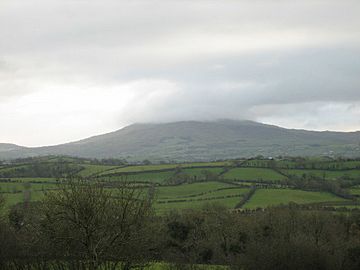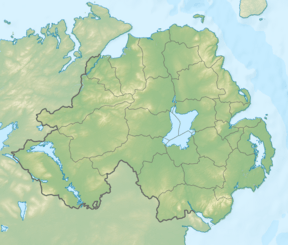Slieve Croob facts for kids
Quick facts for kids Slieve Croob |
|
|---|---|
| Sliabh Crúibe | |
 |
|
| Highest point | |
| Elevation | 534 m (1,752 ft) |
| Prominence | 439 m (1,440 ft) |
| Listing | Marilyn |
| Naming | |
| English translation | mountain of the hoof |
| Language of name | Irish |
| Geography | |
| Location | County Down, Northern Ireland |
| Parent range | Dromara Hills |
| OSI/OSNI grid | J318453 |
Slieve Croob is a mountain in the middle of County Down, Northern Ireland. Its name comes from the Irish words Sliabh Crúibe, which means "mountain of the hoof". This mountain stands tall at 534 meters (about 1,752 feet).
Slieve Croob is the main mountain in an area called the Dromara Hills. These hills are located just north of the famous Mourne Mountains. The whole area around Slieve Croob is so beautiful that it has been named an Area of Outstanding Natural Beauty. This means it's a special place protected for its amazing scenery. The River Lagan, an important river, actually starts its journey on Slieve Croob.
You can find a small road leading up to the top of the mountain. At the summit, there's an old stone pile called a cairn. There are also several radio masts and transmitter stations for communications. From the top, you get amazing views across all of County Down and even further away! Other mountains in the Dromara Hills include Slievenisky, Cratlieve, Slievegarran, and Slievenaboley.
What is the History of Slieve Croob?
Slieve Croob might have been called Brí Erigi or Brí Airige in very old writings from the Middle Ages. The large stone pile, or cairn, on its summit is thought to be the remains of an ancient burial mound. It might even be a type of passage tomb, similar to the one found on Slieve Gullion.
How Was the Cairn Built?
In the 1800s, people described the cairn as being about 70 meters (77 yards) around. It was also about 16 meters (18 yards) tall in a cone shape. Around its base, there were 42 large "pillar stones" or kerbstones. When it was first built, the cairn would have had a very clear and neat shape. However, over many years, it has slowly changed shape. Visitors have also caused some damage to it.
What Does Folklore Say About the Cairn?
According to old Irish folklore, it is considered bad luck to damage these ancient cairns. Some of the stones from the main cairn have been moved and piled into smaller cairns on top of it. Because of this, the summit of Slieve Croob earned the nickname 'The Twelve Cairns'.
What Traditions Are Associated with Slieve Croob?
For a long time, people have gathered on the summit of Slieve Croob during a festival called Lughnasadh. This festival celebrates the harvest. During these gatherings, people would add a stone to one of the cairns. They would also pick and eat bilberries, which are small, dark berries. The celebrations often included traditional folk music, dancing, and games.
Today, local people still climb Slieve Croob on the first Sunday in August. This day is sometimes called Cairn Sunday or Blaeberry Sunday. When they climb, they often carry a stone up the mountain. This tradition is said to help bury twelve ancient kings who are believed to be buried at the top of the mountain.
What Other Ancient Sites Are Nearby?
The Legananny Dolmen is another interesting ancient site. It sits on the southern slopes of Slieve Croob. You can find it close to the village of Leitrim.
Images for kids





